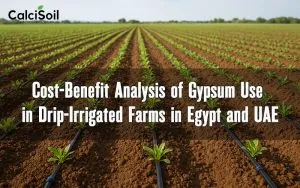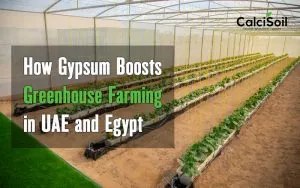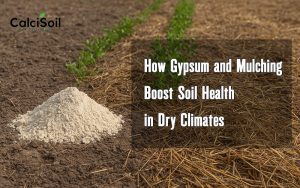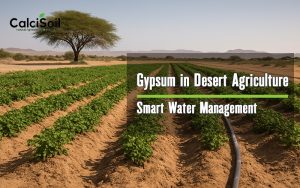
Agricultural gypsum (calcium sulfate) is an excellent improver of the physical and chemical properties of the soil. Gypsum is used in agriculture to improve
Gypsum effects soil physical properties:
Gypsum applications can reduce dispersion and promote the stabilization of the soil structure (flocculation). The benefits obtained with the application of gypsum in this type of soil are greater infiltration and percolation of water. that also help reduce erosion and improve the efficiency of water use. This effect occurs in clay soils to a greater extent. Gypsum helps reduce the dispersion of clays that lead to crusting and also slows down the rate of surface drying.
Thus, rate of scab development and ultimate strength are affected by gypsum additions, significantly improving seedling emergence and crop establishment. Field studies in various world parts have indicated that crop yields can be increased significantly by adding gypsum to soil. due in part to improving the crop emergence by the increasing air molecules and favoring the entry of the moisture.
Effect of gypsum on the chemical properties of the soil:
Gypsum has been used as a source of sulfur in many soils deficient in this macro nutrient. where improvements in production have been obtained in crops such as corn, soybeans, canola and alfalfa. Gypsum has the ability to provide a continuous release of sulfur and calcium in the soil for a long time. given its moderate solubility. The acidity of the land has detrimental effects on plant growth. normally this acidity (pH) is corrected with the incorporation of agricultural lime.
In this soil type, gypsum application on soil surface affects the physical and chemical properties of the soil in depth. thanks to its greater solubility. The effect of gypsum in modifying surface or subsurface pH is relatively modest. However, gypsum can improve phytotoxic conditions derived from excess soluble aluminum by reaction with aluminum Al 3+. so that you can push it out of the soil solution.
By reducing the toxic effects of aluminum, plants are able to root deeper. and the rate of absorption of water and nutrients by plants is increased. This is especially important in the dry season of arid areas. In the case of sodic soils, sodium is a harmful element for the soil. since it affects its physical properties, causing the flocculation of the clays and the collapse of the aggregates. This leads to soil compaction, loss of water infiltration and severe limitations in vertical air conduction.
The use of gypsum is a common practice for the rehabilitation of sodic soils. Gypsum provides Calcium ions (Ca) that can be exchanged with sodium ions (Na), thus leading to flocculation of soil particles. Application of agricultural gypsum in crops such as peanuts improve the production and quality of crops. Root crops seem to be especially sensitive to calcium. for example the use of gypsum as a calcium fertilizer for peanuts is well known. Peanut root rot caused by Phytophthora, blossom end rot in watermelon and tomato, and bitter-pit rot in apples are also partially controlled with agricultural gypsum applications.
Forms and time of application of agricultural gypsum
The application method will depend on the intended purposes. In general, the gypsum can be applied in solid form or dissolved in the irrigation water, as long as the powder is fine enough. When powders or granules are used they can be applied directly to the soil surface using spreaders. Gypsum application should be avoided in high wind conditions. On the other hand, if the intention is to get the gypsum into the subsurface as quickly as possible and if there is a need to prevent and reduce erosion, irrigation must follow immediately after application.







